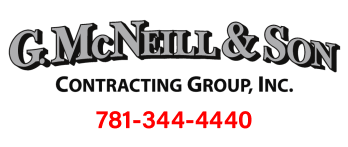The best practices for advanced snow plowing management involves the use of heavy-duty equipment like push boxes or trucks equipped with v-plows and salters in order the clear a large mass of snow from an area. Advanced snow plowing is often used to clear snow from commercial properties like shopping centers, healthcare facilities, and industrial properties, but can be used for residential properties as well.
Tackling large amounts of snow can be a rather steep hill to climb, so snow removal companies often follow a fixed set of procedures to complete the process safely and efficiently.
Companies like G. McNeill & Son, who offer snow clearing services in the hard-hit areas of Massachusetts, Rhode Island, and New Hampshire, often follow the Occupational Safety and Health Administration’s guidelines for snow removal. McNeill also adheres to the Snow and Ice Management Association’s (SIMA) list of best practices to ensure top quality snow removal service.
The process of following best practices for advanced snow removal is exhaustive and includes not only safety practices but also procedures than ensure minimal impact on the environment. Companies like McNeill also tailor their snow removal process to each respective client’s needs, meaning they must follow a detailed and precise list to exceed each client’s expectations.
Risk and Property Assessments
Safety is a top concern when it comes to advanced snow plowing. The first step in the process is a thorough assessment of the property for any potential complications or risk factors.
McNeill takes a proactive approach to risk assessment, monitoring the before, during, and after a winter event. Their proactive approach helps them minimize risk by being one step ahead and reduces costs for their clients. They inspect their client’s property long before winter comes around to assess and photograph areas. They use the photos to craft a snow response plan tailored to the property’s needs.
Based on the property assessment, appropriate equipment and materials are assigned beforehand to ensure there is no waiting period for a particular material after a snowfall. Creating a plan before a winter storm allows team members to get to work the minute they arrive on-site and lowers the margin for error.
Site Inspections
As mentioned, a pre-season site inspection is crucial in meeting each property’s specific needs, and this process involves several key components.
Property Mapping and Snow Mapping
Property mapping involves creating a blueprint, often an overhead photo, of the property to pinpoint high-risk and damaged areas. Creating a property map also helps keep track of snow locations. Creating a property map allows contractors to target critical areas when performing a snow removal service, speeding up the process overall.
Documenting Hazards
Having a documented list of hazards on a particular property helps workers know what they are up against before heading to a job site and minimizes the risk of encountering unforeseen complications. Hazards on commercial properties can include speed bumps, drainage locales, manholes, or general damage to the pavement.
Snow Placement and Disposal
The inspection needs to address snow placement. Property managers often have specific requests as to where they would like the removed snow placed. For instance, in parking lots, snow will need to be placed where it does not block parking spaces and does not obstruct fire hydrants.
Sometimes, the property manager will request to have snow removed from the site during the inspection. They document the disposal process and disposal location before so that the process can run smoothly.
Hours of Operation
The pre-season inspection needs to discuss business hours. Removing snow during peak hours is less than ideal, and the property manager may have specific times in mind when snow removal is suitable. Having set snow removal hours limits confusion over whether snow should be cleared, and helps workers organize their time so that they can tackle removal soon after a snowfall.
Meeting with Property Managers
Clear communication between the property manager and a contractor is essential when snow removal tailors to the customer. Meeting the expectations for a client will forge a bond and is a sure way to sustain a long working relationship. Following a list of best practices for advanced snow plow management like the ones outlined by SIMA will help check all boxes for the client.

